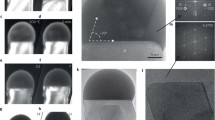Abstract
We report on the growth of nanowires and unusual hollow microducts of tungsten oxide by thermal treatment of tungsten films in a radio frequency H2/Ar plasma at temperatures between 550 and 620 °C. Nanowires with diameters of 10–30 nm and lengths between 50 and 300 nm were formed directly from the tungsten film, while under certain specific operating conditions hollow microducts having edge lengths∼0.5 μm and lengths between 10 and 200 μm were observed. Presence of a reducing gas such as H2 was crucial in growing these nanostructures as were trace quantities of oxygen, which was necessary to form a volatile tungsten species. Preferential restructuring of the film surface into nanowires or microducts appeared to be influenced significantly by the rate of mass transfer of gas-phase species to the surface. Nanowires were also observed to grow on tungsten wires under similar conditions. A surface containing nanowires, annealed at 500 °C in air, exhibited the capability of sensing trace quantities of nitrous oxides (NOx).
Similar content being viewed by others
References
Y. Xia, P. Yang, Y. Sun, Y. Wu, B. Mayers, B. Gates, Y. Yin, F. Kim and H. Yan: One-dimensional nanostructures: Synthesis, characterization and applications. Adv. Mater. 15, 353 (2003).
C.N.R. Rao, F.L. Deepak, G. Gundiah and A. Govindaraj: Inorganic nanowires. Prog. Solid State Chem. 31, 5 (2003).
S. Iijima: Helical microtubules of graphitic carbon. Nature 354, 56 (1991).
R.B.R.C. Haddon, (ed.), Special Issue on Carbon Nanotubes. Acc. Chem. Res. 35, 997 (2002).
Z.W. Pan, Z.R. Dai and Z.L. Wang: Nanobelts of semiconducting oxides. Science 291, 1947 (2001).
S. Matsui and Y. Ochiai: Focused ion beam applications to solid state devices. Nanotechnology 7, 247 (1996).
B. Gates, B. Mayers, B. Cattle and Y. Xia: Novel nanostructures of functional oxides synthesized by thermal evaporation. Adv. Funct. Mater. 12, 219 (2002).
Y. Zhang, N. Wang, S. Gao, R. He, S. Miao, J. Liu, J. Zhu and X. Zhang: A simple method to synthesize nanowires. Chem. Mater. 14, 3564 (2002).
J.C. Hulteen and C.R. Martin: A general template-based method for the preparation of nanomaterials. J. Mater. Chem. 7, 1075 (1997).
C. Mu, Y. Yu, R. Wang, K. Wu, D. Xu and G. Guo: Uniform metal nanotube arrays by multistep template replication and electrodeposition. Adv. Mater. 16, 1550 (2004).
E.C. Walter, K. Ng, M.P. Zach, R.M. Penner and F. Favier: Electronic devices from electrodeposited metal nanowires. Microelectron. Eng. 61–62, 555 (2002).
E. Tosatti and S. Prestipino: Weird gold nanowires. Science 289, 561 (2000).
Y.H. Lee, C.H. Choi, Y.T. Jang, E.K. Kim, B.K. Ju, N.K. Min and J.H. Ahn: Tungsten nanowires and their field electron-emission properties. Appl. Phys. Lett. 81, 745 (2002).
G. Gu, B. Zheng, W.Q. Han, S. Roth and J. Liu: Tungsten oxide nanowires on tungsten substrates. Nano Lett. 2, 849 (2002).
J. Zhou, N.S. Xu, S.Z. Deng, J. Chen, J.C. She and Z.L. Wang: Large area nanowire arrays of molybdenum and molybdenum oxides: Synthesis and field-emission properties. Adv. Mater. 15, 1835 (2003).
J. Liu, Y. Zhao and Z. Zhang: Low-temperature synthesis of large-scale arrays of aligned tungsten oxide nanorods. J. Phys.: Cond. Mater. 15, 453 (2003).
S. Vaddiraju, H. Chandrasekaran and M. Sunkara: Vapor phase synthesis of tungsten nanowires. J. Am. Chem. Soc. 125, 10792 (2003).
F. Okuyama: Crystalline tungsten grown by reducing vapor-deposited tungsten oxide. J. Cryst. Growth 38, 103 (1977).
D. Veblen and J. Post: A TEM study of fibrous cuprite (chalcotrichite): Microstructures and growth mechanisms. Am. Mineral. 68, 790 (1983).
V.K. Sarin: Morphological changes occurring during the reduction of WO3. J. Mater. Sci. 10, 593 (1975).
W.B. Hu, Y.Q. Zhu, W.K. Hsu, B.H. Chang, M. Terrones, N. Grobert, H. Terrones, J.P. Hare, H.W. Kroto and D.R.M. Walton: Generation of hollow crystalline tungsten oxide fibers. Appl. Phys. A 70, 231 (2000).
Y. Li, Y. Bando and D. Goldberg: Quasi-aligned single-crystalline W18O49 nanotubes and nanowires. Adv. Mater. 15, 1294 (2003).
B. Mayers and Y. Xia: Formation of tellurium nanotubes through concentration depletion at the surface of seeds. Adv. Mater. 14, 279 (2002).
J.L. Solis, A. Hoel, L.B. Kish, S. Sauko, V. Lantto and C.G. Granqvist: Gas sensing properties of nanocrystalline WO3 films made by advanced reactive gas deposition. J. Am. Ceram. Soc. 84, 1504 (2001).
J.S. Suehle, R.E. Cavicchi, M. Gaitan and S. Semancik: Tin oxide gas sensor fabricated using CMOS microhotplates and in-situ processing. IEEE Electron Device Lett 14, 118 (1993).
R.E. Cavicchi, S. Semancik, F. DiMeo Jr. and C.J. Taylor: Use of microhotplates in the controlled growth and characterization of metal oxides for chemical sensing. J. Electroceram 9, 155 (2002).
Author information
Authors and Affiliations
Corresponding author
Rights and permissions
About this article
Cite this article
Parthangal, P.M., Cavicchi, R.E., Montgomery, C.B. et al. Restructuring tungsten thin films into nanowires and hollow square cross-section microducts. Journal of Materials Research 20, 2889–2894 (2005). https://doi.org/10.1557/JMR.2005.0373
Received:
Accepted:
Published:
Issue Date:
DOI: https://doi.org/10.1557/JMR.2005.0373



